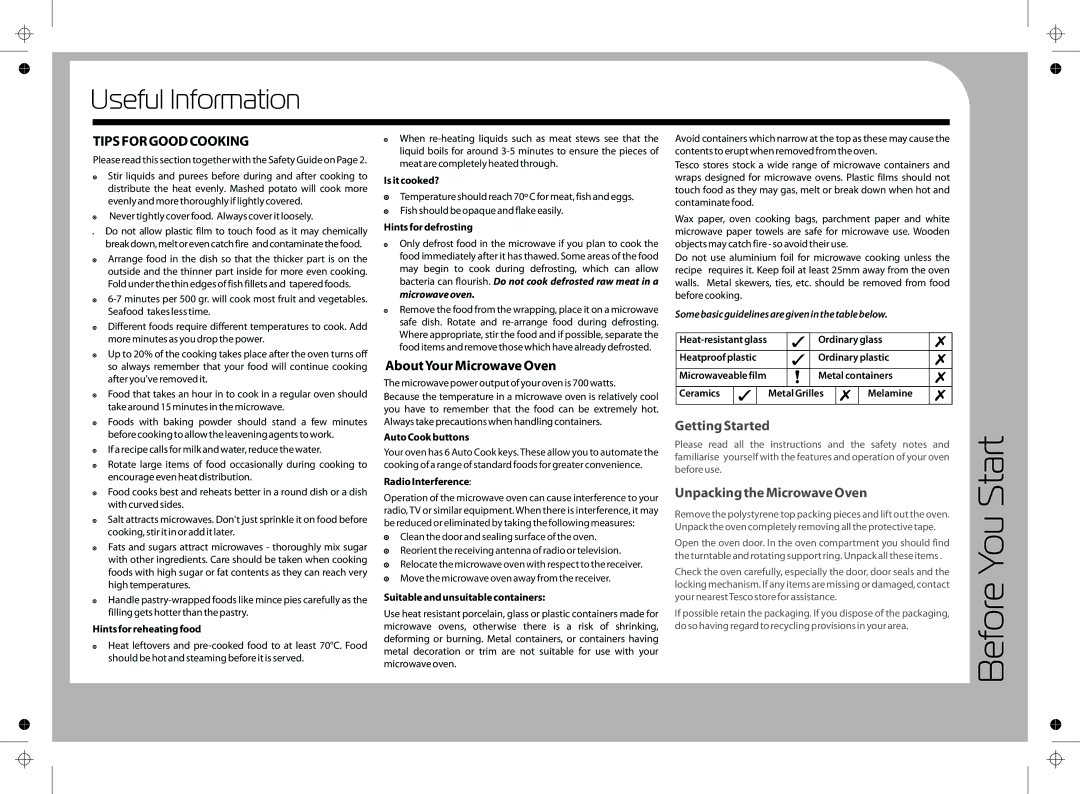
Useful Information
TIPS FOR GOOD COOKING
Please read this section together with the Safety Guide on Page 2.
$Stir liquids and purees before during and after cooking to distribute the heat evenly. Mashed potato will cook more evenly and more thoroughly if lightly covered.
$Never tightly cover food. Always cover it loosely.
$Do not allow plastic film to touch food as it may chemically break down, melt or even catch fire and contaminate the food.
$Arrange food in the dish so that the thicker part is on the outside and the thinner part inside for more even cooking. Fold under the thin edges of fish fillets and tapered foods.
$Different foods require different temperatures to cook. Add more minutes as you drop the power.
$Up to 20% of the cooking takes place after the oven turns off so always remember that your food will continue cooking after you've removed it.
$Food that takes an hour in to cook in a regular oven should take around 15 minutes in the microwave.
$Foods with baking powder should stand a few minutes before cooking to allow the leavening agents to work.
$If a recipe calls for milk and water, reduce the water. $Rotate large items of food occasionally during cooking to
encourage even heat distribution.
$Food cooks best and reheats better in a round dish or a dish with curved sides.
$Salt attracts microwaves. Don't just sprinkle it on food before cooking, stir it in or add it later.
$Fats and sugars attract microwaves - thoroughly mix sugar with other ingredients. Care should be taken when cooking foods with high sugar or fat contents as they can reach very high temperatures.
$Handle
Hints for reheating food
$Heat leftovers and
$When
Is it cooked?
$Temperature should reach 70º C for meat, fish and eggs. $Fish should be opaque and flake easily.
Hints for defrosting
$Only defrost food in the microwave if you plan to cook the food immediately after it has thawed. Some areas of the food may begin to cook during defrosting, which can allow bacteria can flourish. Do not cook defrosted raw meat in a
microwave oven.
$Remove the food from the wrapping, place it on a microwave safe dish. Rotate and
AboutYour Microwave Oven
The microwave power output of your oven is 700 watts.
Because the temperature in a microwave oven is relatively cool you have to remember that the food can be extremely hot. Always take precautions when handling containers.
Auto Cook buttons
Your oven has 6 Auto Cook keys. These allow you to automate the cooking of a range of standard foods for greater convenience.
Radio Interference:
Operation of the microwave oven can cause interference to your radio, TV or similar equipment. When there is interference, it may be reduced or eliminated by taking the following measures: $Clean the door and sealing surface of the oven. $Reorient the receiving antenna of radio or television. $Relocate the microwave oven with respect to the receiver. $Move the microwave oven away from the receiver.
Suitable and unsuitable containers:
Use heat resistant porcelain, glass or plastic containers made for microwave ovens, otherwise there is a risk of shrinking, deforming or burning. Metal containers, or containers having metal decoration or trim are not suitable for use with your microwave oven.
Avoid containers which narrow at the top as these may cause the contents to erupt when removed from the oven.
Tesco stores stock a wide range of microwave containers and wraps designed for microwave ovens. Plastic films should not touch food as they may gas, melt or break down when hot and contaminate food.
Wax paper, oven cooking bags, parchment paper and white microwave paper towels are safe for microwave use. Wooden objects may catch fire - so avoid their use.
Do not use aluminium foil for microwave cooking unless the recipe requires it. Keep foil at least 25mm away from the oven walls. Metal skewers, ties, etc. should be removed from food before cooking.
Some basic guidelines are given in the table below.
Ordinary glass | ||
Heatproof plastic | Ordinary plastic | |
Microwaveable film | Metal containers | |
Ceramics | Metal Grilles | Melamine |
Getting Started
Please read all the instructions and the safety notes and familiarise yourself with the features and operation of your oven before use.
Unpacking the Microwave Oven
Remove the polystyrene top packing pieces and lift out the oven. Unpack the oven completely removing all the protective tape.
Open the oven door. In the oven compartment you should find the turntable and rotating support ring. Unpack all these items .
Check the oven carefully, especially the door, door seals and the locking mechanism. If any items are missing or damaged, contact your nearestTesco store for assistance.
If possible retain the packaging. If you dispose of the packaging, do so having regard to recycling provisions in your area.
